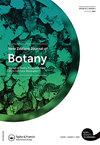广泛分布的新西兰树柳叶木/胡罗卡的系统地理学(厚叶假人参;天南星科)
IF 1.4
4区 生物学
Q4 PLANT SCIENCES
引用次数: 2
摘要
了解遗传变异的空间分布是理解生物多样性产生和维持过程的必要条件。然而,对新西兰奥特罗阿广泛分布的森林树木的系统地理研究很少,迄今为止的研究表明在系统地理模式上几乎没有一致性。pseudoopanax crassifolius (lancewood/horoeka)是一种分布广泛的低地森林乔木,新西兰奥特罗阿特有。我们利用微卫星和叶绿体单倍型对该物种的系统地理学进行了研究,并将研究结果与已发表的亲缘关系密切的狐猴(P. ferox)的研究结果进行了比较。狐猴也广泛分布在低地,但其生态偏好不同。微卫星基因分型结果显示,沙棘有两个弱分化的遗传群。一组包括来自北岛的所有个人加上来自南岛东北部和中东部的个人。第二个种群的遗传变异水平低于北部种群,它包括南岛的南部和西部。南群的遗传多样性较低,特别是南岛南部,表明该物种在末次盛冰期(Last Glacial Maximum, LGM)期间在该地区受到严重限制,甚至灭绝。这一结果与在亲缘关系密切的铁狐猴中观察到的高水平遗传结构形成对比。在南岛东南部,有不对称叶绿体向粗叶假单胞植物渗入的证据。本文还讨论了可能导致这种不对称渗入的其他情况。本文章由计算机程序翻译,如有差异,请以英文原文为准。
Phylogeography of the widespread New Zealand tree lancewood/horoeka (Pseudopanax crassifolius; Araliaceae)
ABSTRACT Understanding how genetic variation is spatially distributed is necessary for understanding the processes that generate and maintain biodiversity. However, there has been little investigation into the phylogeography of widespread forest trees in Aotearoa New Zealand with studies to date showing little congruence in phylogeographic patterns. Pseudopanax crassifolius (lancewood/horoeka) is a widespread lowland forest tree endemic to Aotearoa New Zealand. We investigated the phylogeography of this species using microsatellites and chloroplast haplotypes and compare the results to published results from the closely-related P. ferox, which also has a widespread lowland distribution, but differs in its ecological preferences. Microsatellite genotypes revealed two weakly differentiated genetic clusters within P. crassifolius. One cluster comprised all individuals from the North Island plus those from the north-eastern and central-eastern South Island. The second cluster, which had lower levels of genetic variation than the northern cluster, encompassed the southern and western South Island. The southern cluster exhibited lower genetic diversity, particularly in the southern South Island, suggesting that the species was severely restricted, or even extirpated, from this region during the Last Glacial Maximum (LGM). This result contrasts with the high level of genetic structuring observed in the closely-related P. ferox. There was evidence of asymmetric chloroplast introgression from P. ferox into P. crassifolius in the south-eastern South Island. Alternative scenarios that may have led to this asymmetric introgression are discussed.
求助全文
通过发布文献求助,成功后即可免费获取论文全文。
去求助
来源期刊

New Zealand Journal of Botany
生物-植物科学
CiteScore
2.20
自引率
22.20%
发文量
27
审稿时长
>12 weeks
期刊介绍:
The New Zealand Journal of Botany publishes original research papers, review papers, perspectives, short communications, forum articles, letter and book reviews. We welcome submissions relevant to all aspects of the botany, mycology, and phycology of the South Pacific, Australia, South America, and Southern Africa. The journal’s subject matter encompasses biosystematics and biogeography, ecology, physiology, biochemistry, genetics, reproductive biology, structure and development, taxonomy, ethnobotany, palaeobotany, bryology, lichenology, mycology, plant pathology, and phycology.
 求助内容:
求助内容: 应助结果提醒方式:
应助结果提醒方式:


